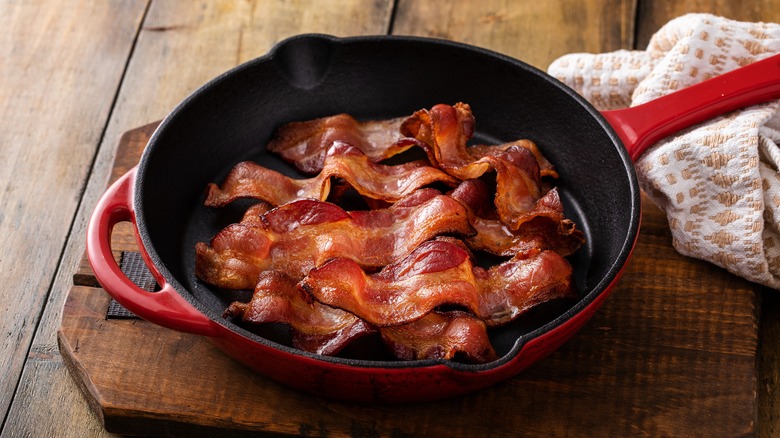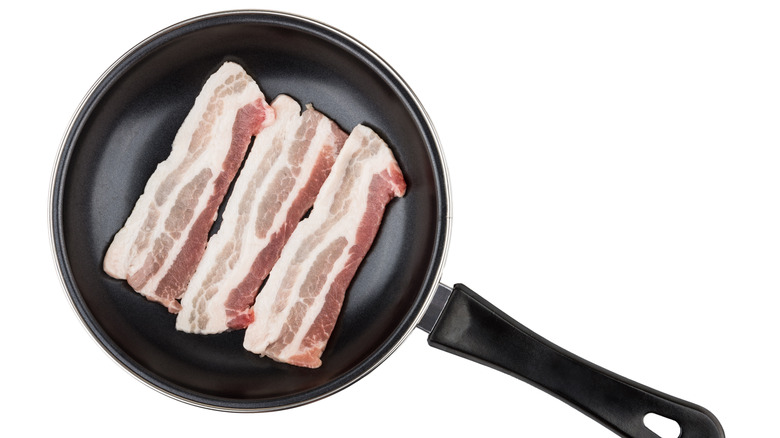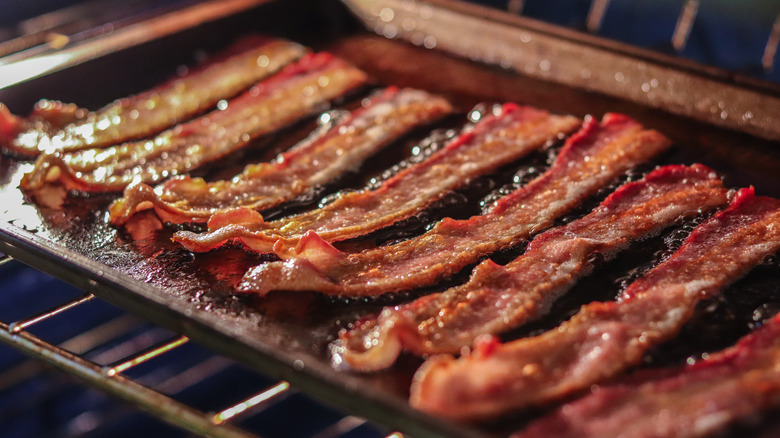Why Your Bacon Is Burnt And Undercooked At The Same Time
While everyone may have their own preference when it comes to the exact doneness of bacon, it's fair to say that most of us want some level of crispiness and nearly none of us want it to be burnt into oblivion. For less experienced cooks, it can be far too easy to wind up with bacon that is both undercooked and floppy yet charred in some spots, which is a disappointing start to the day.
If you've been plagued by bacon that's simultaneously burnt and undercooked, chances are you've been putting those fatty pieces of pork into a pan that's way too hot. In fact, your skillet shouldn't be very hot at all. If your slices are sizzling as soon as they're on the stove, you can bet that in a few minutes, they'll be blackened in some parts yet unappealingly soggy in others.
Exposing the bacon to too much heat all at once makes it impossible for the fat to cook properly alongside the meaty portion of each slice. The meat cooks too fast, while the fat doesn't have time to render. Fortunately, all you need is a cold pan and a little patience to avoid this bacon blunder.
How to cook bacon correctly
The key to perfectly crispy bacon is to allow the bacon slices and the skillet to heat up gradually. Simply place the pork in the cold pan before turning up the temperature of the stove. Keep in mind that low and slow is the way to go — avoid increasing the heat above a medium setting.
If you're making a large batch of bacon, you'll want to be prepared with multiple pans so that each batch starts in a pan that is cold — otherwise, you'll need to wait for the pan to cool off each time. Alternatively, you can make large batches of bacon on a sheet pan in the oven. In this case, you'll want to use the same strategy of starting off cold. Place the slices on a cool baking tray before putting it in an unheated oven. Then, turn the oven on to heat it up.
There's just one caveat when it comes to keeping coolness in mind: While the pan or oven should always be cold, your bacon should be around room temperature for even cooking. Pull the package out of the fridge so that it can rest until it comes close to room temperature, then begin to cook.
Other tips for the best bacon
If you're still struggling to make bacon correctly, there are a few other ways to achieve perfection. First, be sure to use a pan that heats uniformly, and not too quickly — cast iron skillets are the ideal option for making bacon on the stovetop.
As for the oven, be sure to use a pan that has a high enough rim around the sides to avoid grease spills. You can also find baking sheets sold with wire racks that may help you achieve the perfect crispiness. This helps to separate the bacon from its rendered fat, and allows the oven's hot air to surround all of the bacon's surface area. If you're trying to avoid clogging up your cabinets with another kitchen tool, you can recreate a fat-draining setup by placing the bacon on a wire cooling rack that's resting on a baking sheet.
Finally, to avoid soggy, soft slices, always leave an ample amount of room between each slice of bacon while cooking. Then, once removed from the skillet or oven, transfer the bacon to a plate or tray lined with paper towels to absorb any excess moisture that could interfere with the crispiness of your fried or baked bacon.



